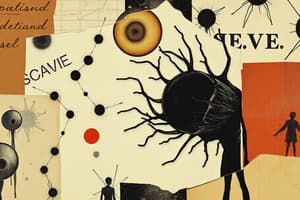Podcast
Questions and Answers
What is the primary consequence of increased cyclophilin D activity?
What is the primary consequence of increased cyclophilin D activity?
- Reduced cell survival
- Enhanced mitochondrial membrane permeability
- Inhibition of mitochondrial potential loss
- Increased necrosis or apoptosis (correct)
How does downregulation of Apaf-1 affect apoptosis?
How does downregulation of Apaf-1 affect apoptosis?
- It enhances the release of cytochrome c
- It promotes apoptosis by increasing procaspase activity
- It blocks the formation of the apoptosome, reducing apoptosis (correct)
- It has no effect on apoptosis
What effect does increased MPTP opening have on cell survival?
What effect does increased MPTP opening have on cell survival?
- It leads to necrosis or apoptosis (correct)
- It stabilizes mitochondrial potential
- It enhances cell survival
- It inhibits cytochrome c release
Which of the following statements about Bcl-2 is accurate?
Which of the following statements about Bcl-2 is accurate?
What role does cytochrome c play in apoptosis?
What role does cytochrome c play in apoptosis?
What is a consequence of blocking the opening of MPTP?
What is a consequence of blocking the opening of MPTP?
What happens to apoptotic processes when cyclophilin D is inhibited?
What happens to apoptotic processes when cyclophilin D is inhibited?
What does the release of cytochrome c indicate in a cell?
What does the release of cytochrome c indicate in a cell?
What is the direct consequence of excessive opening of the MPTP?
What is the direct consequence of excessive opening of the MPTP?
In what way does Bcl-2 contribute to the regulation of apoptosis?
In what way does Bcl-2 contribute to the regulation of apoptosis?
What is a defining characteristic of necrosis?
What is a defining characteristic of necrosis?
Which of the following best describes the process of apoptosis?
Which of the following best describes the process of apoptosis?
Which pathway is NOT involved in apoptosis?
Which pathway is NOT involved in apoptosis?
What is a potential result of necrosis on surrounding tissues?
What is a potential result of necrosis on surrounding tissues?
What is NOT a characteristic feature of apoptosis?
What is NOT a characteristic feature of apoptosis?
During which process does cytochrome c play a crucial role?
During which process does cytochrome c play a crucial role?
What is the main outcome of apoptosis, unlike necrosis?
What is the main outcome of apoptosis, unlike necrosis?
Which event occurs during necrosis?
Which event occurs during necrosis?
Which statement about autophagy is most accurate?
Which statement about autophagy is most accurate?
Which is true about the extrinsic pathway of apoptosis?
Which is true about the extrinsic pathway of apoptosis?
What is the primary role of caspase-3 in the apoptosis process?
What is the primary role of caspase-3 in the apoptosis process?
Which component initiates the formation of the apoptosome in the intrinsic pathway?
Which component initiates the formation of the apoptosome in the intrinsic pathway?
What function does the mitochondrial permeability transition pore (MPTP) serve in apoptosis?
What function does the mitochondrial permeability transition pore (MPTP) serve in apoptosis?
Which protein is critical in regulating the balance between apoptosis and necrosis through MPTP?
Which protein is critical in regulating the balance between apoptosis and necrosis through MPTP?
How is procaspase-9 activated in the intrinsic apoptosis pathway?
How is procaspase-9 activated in the intrinsic apoptosis pathway?
What is the primary role of autophagy in cells?
What is the primary role of autophagy in cells?
Which statement accurately describes apoptosis compared to necrosis?
Which statement accurately describes apoptosis compared to necrosis?
Which caspase is primarily involved in the execution phase of apoptosis?
Which caspase is primarily involved in the execution phase of apoptosis?
What triggers the intrinsic pathway of apoptosis?
What triggers the intrinsic pathway of apoptosis?
What process occurs immediately before the formation of apoptotic bodies?
What process occurs immediately before the formation of apoptotic bodies?
Which of the following proteins is involved in the activation of the extrinsic pathway of apoptosis?
Which of the following proteins is involved in the activation of the extrinsic pathway of apoptosis?
What is the role of cytochrome c in apoptosis?
What is the role of cytochrome c in apoptosis?
In apoptosis, how are apoptotic bodies removed from the system?
In apoptosis, how are apoptotic bodies removed from the system?
Which process directly involves death domains in apoptosis?
Which process directly involves death domains in apoptosis?
What is a significant consequence of excessive autophagy?
What is a significant consequence of excessive autophagy?
What happens when caspase-3 activity is reduced?
What happens when caspase-3 activity is reduced?
What is the effect of upregulating procaspase-8?
What is the effect of upregulating procaspase-8?
What role does caspase-9 play in the intrinsic apoptosis pathway?
What role does caspase-9 play in the intrinsic apoptosis pathway?
What is the consequence of downregulating Bax?
What is the consequence of downregulating Bax?
What occurs with disrupted formation of the apoptosome?
What occurs with disrupted formation of the apoptosome?
Which outcome is associated with enhanced Bax activity?
Which outcome is associated with enhanced Bax activity?
What is the impact of reduced caspase-8 activity?
What is the impact of reduced caspase-8 activity?
What results from increased levels of cellular caspase-9?
What results from increased levels of cellular caspase-9?
Study Notes
Caspase Function and Regulation
- Caspase-3: Key executioner in apoptosis. Increased activity promotes apoptosis, while reduced activity allows potentially harmful cells to survive.
- Caspase-8: An initiator caspase in the extrinsic pathway; activated by death receptors. Upregulation enhances apoptosis, while downregulation or mutations lead to impaired apoptosis, facilitating tumorigenesis.
- Caspase-9: Initiator in the intrinsic pathway, activated by the apoptosome. Increased activity promotes apoptosis; downregulation leads to cell survival, particularly in cancerous conditions.
Pro-Apoptotic and Anti-Apoptotic Factors
- Bax: Pro-apoptotic member of Bcl-2 family. Promotes mitochondrial outer membrane permeabilization, facilitating cytochrome c release. Upregulation increases apoptosis, while downregulation inhibits it, enhancing cell survival and cancer risk.
- Bcl-2: Anti-apoptotic protein that prevents cytochrome c release by inhibiting pro-apoptotic proteins. Upregulation blocks apoptosis, promoting cell survival.
Apoptosome and Its Role
- Apoptosome: Complex formed by Apaf-1, cytochrome c, and procaspase-9. It initiates caspase-9 activation. Disruption prevents apoptosis, while enhanced formation accelerates apoptosis via the intrinsic pathway.
Mitochondrial Dynamics in Cell Death
- Cyclophilin D: Regulates the mitochondrial permeability transition pore (MPTP). Upregulation increases cell death via necrosis/apoptosis; its inhibition promotes cell survival.
- MPTP: Pore that, when opened, leads to mitochondrial depolarization and release of pro-apoptotic factors, promoting necrosis/apoptosis. Restricted opening enhances survival under stress.
Cytochrome c and Apaf-1 Function
- Cytochrome c: Released from mitochondria during apoptosis. It binds to Apaf-1 to form the apoptosome, driving apoptosis. Its release correlates with increased apoptosis; sequestration leads to reduced apoptosis.
- Apaf-1: Activates procaspase-9 when bound to cytochrome c, forming the apoptosome. Increased activity enhances apoptosis; decreased activity blocks it, promoting cell survival.
Comparison of Cell Death Processes
- Necrosis: Uncontrolled and passive; results in cell swelling, rupture, and inflammation, typically harmful.
- Apoptosis: Programmed and regulated; allows for the removal of damaged cells without inflammation. Initiated either intrinsically (via mitochondrial signals) or extrinsically (via death receptors).
- Autophagy: A recycling process during stress, can lead to cell death if excessive. It blurs the line between survival and apoptosis.
General Steps of Apoptosis
- Initiation: Intrinsic (damage) or extrinsic (death signals) pathways activate apoptotic mechanisms.
- Caspase Activation: Caspase-8 and caspase-9 activate executioner caspases.
- Execution Phase: Caspases dismantle cellular components, leading to cell shrinkage and fragmentation.
- Apoptotic Bodies Formation: The cell breaks into membrane-bound fragments for phagocytosis.
- Phagocytosis: Engulfment of apoptotic bodies by macrophages without inflammation.
Studying That Suits You
Use AI to generate personalized quizzes and flashcards to suit your learning preferences.
Related Documents
Description
Explore the crucial roles of caspases and apoptotic factors like Bax and Bcl-2 in cell death mechanisms. This quiz examines how their regulation affects apoptosis and cancer development. Test your knowledge on pro- and anti-apoptotic signals that maintain cellular health.





